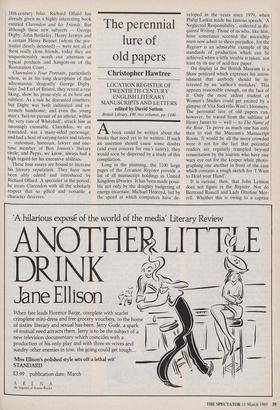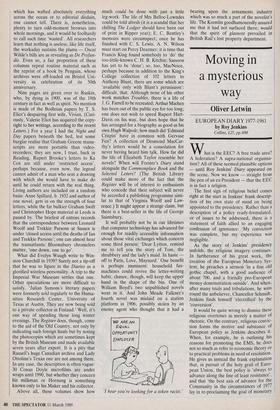The perennial lure of old papers
Christopher Hawtree
LOCATION REGISTER OF TWENTIETH-CENTURY ENGLISH LITERARY MANUSCRIPTS AND LETTERS edited by David Sutton
British Library, £90, two volumes, pp. 1100
Abook could be written about the books that need yet to be written. If such an assertion should cause some doubts (and even concern for one's sanity), they would soon be dispersed by a study of this compilation.
Long in the planning, the 1100 large pages of the Location Register provide a list of all manuscript holdings in United Kingdom libraries. It has been made possi- ble not only by the doughty badgering of energy incarnate, Michael Holroyd, but by the speed at which computers have de- veloped in the years since 1979, when Philip Larkin made his famous speech, 'A Neglected Responsibility', collected in Re- quired Writing. Those of us who, like him, have sometimes scorned the microchip must now admit to sheer prejudice, for the Register is an admirable example of the standards of production which can be achieved when a little trouble is taken, not least by its use of acid-free paper.
On display in the British Museum is a Shaw postcard which expresses his aston- ishment that anybody should be in- terested by an 'author's mistakes'. This appears reasonable enough, on the face of it. Only the most ardent student of Women's Studies could get excited by a glimpse of Vita Sackville-West's bloomers. The perennial lure of old papers can, however, be traced from the sublime of Henry James to — well — to The Name of the Rose. To prove as much one has only then to visit the Museum's Manuscript Room. It would be all the more crowded were it not for the fact that potential readers are regularly trampled beyond resuscitation by the tourists who have one wary eye out for the keeper while photo- graphing one another in front of the case which contains a rough sketch for 'I Want to Hold your Hand'.
It is curious, then, that John Lennon does not figure in the Register. Nor do Bertrand Russell and Lady Ottoline Mor- rell. Whether this is owing to a caprice which has wafted absolutely everything across the ocean or to editorial disdain, one cannot tell. There is, nonetheless, plenty to turn odd-moment browses into whole mornings, and it would be foolhardy to call such time 'wasted'. All researchers learn that nothing is useless; like life itself, the workaday sustains the plums — Oscar Wilde's bills are as revealing as De Profun- dis. Even so, a fair proportion of these columns repeat routine material such as the reprint of a book by Penguin, whose archives were off-loaded on Bristol Uni- versity in celebration of its 50th anniversary.
Nine pages are given over to Ruskin, who, by dying in 1900, was of the 19th century in fact as well as spirit. No mention is made of the Bodleian papers by T. S. Eliot's despairing first wife, Vivian. (Curi- ously, Valerie Eliot has acquired the copy- right to her writings, according to the recent Letters.) For a year I had the Night and Day papers beneath the bed, lest some burglar realise that Graham Greene manu- scripts are more portable than video- recorders; they are now, I trust, back in Reading. Rupert Brooke's letters to Ka Cox are still under 'restricted access', perhaps because, even now, the legend cannot admit of a man who sent a drawing with which she would have to make do until he could return with the real thing. Living authors are included on a random basis: Anne Spillard, b. 1932 and author of one novel, gets in on the strength of four letters, while the far bulkier Graham Swift and Christopher Hope material at Leeds is passed by. The briefest of entries records that the correspondence between Leonard Woolf and Trekkie Parsons at Sussex is under 'closed access until the deaths of Ian and Trekkie Parsons'; one can almost hear the transatlantic Bloomsbury chroniclers mutter, 'one down, one to go'.
What did Evelyn Waugh write to Win- ston Churchill in 1939? Surely not a tip-off that he was to figure in the Diaries as a glorified wireless personality. A trip to the Imperial War Museum settles that one. Other speculations are more difficult to satisfy. 'Julian Symons's literary papers were formerly sold regularly to the Huma- nities Research Center, University of Texas at Austin. They are now being sold to a private collector in Finland.' Well, it's one way of spending those long winter evenings. The Register does, though, come to the aid of the Old Country, not only by indicating such foreign hauls but by noting the photocopies which are sometimes kept by the British Museum and made available seven years after export. It is a pity that Russell's huge Canadian archive and Lady Ottoline's Texan one are not among them. In any case, the description is often vague: 30 Conan Doyle microfilms are under wraps until 1990, but whether they concern his milkman or Hornung is something known only to his Maker and his collector.
Above all, these volumes show how
much could be done with just a little leg-work. The life of Mrs Belloc-Lowndes could be told afresh (it is a scandal that her chilling The Lodger should have been out of print in Ripper year); E. C. Bentley's memoirs were circumspect; once he has finished with C. S. Lewis, A. N. Wilson must start on Percy Dearmer; it is time that Francis King found somebody to 'do' the too-little-known C. H. B. Kitchin; Sassoon has yet to be `done'; so, too, MacNeice, perhaps because in addition to the King's College collection of 102 letters to Anthony Blunt, there are some which are 'available only with Blunt's permission': difficult, that. Although none of his other work matches Troubles, there is a life of J. G. Farrell to be recreated; Arthur Machen has been out of the public eye for too long; one does not wish to speed Rupert Hart- Davis on his way, but does hope that he has arranged for a biography as good as his own Hugh Walpole; how much did 'Edmund Crispin' have in common with Gervase Fen? A collection of Desmond MacCar- thy's letters would be a consolation for never having heard him talk. How far did the life of Elizabeth Taylor resemble her novels? When will Forster's Diary stand alongside the Commonplace Book and the Selected Letters? (The British Library could make more of the fact that the Register will be of interest to enthusiasts who concede that their subject will never be accorded a publishing programme simi- lar to that of Virginia Woolf and Law- rence.) It might appear a strange claim, but there is a best-seller in the life of George Saintsbury.
It will probably not be in our lifetimes that computer technology has advanced far enough for readily accessible information about those vital exchanges which concern some third person: 'Dear Lytton, remind me to tell you the story of Tom, the shrubbery and the lady's maid. In haste — off to Paris, Love, Maynard.' One benefit is perhaps imminent: household fax- machines could revive the letter-writing habit; chance, though, will keep the upper hand in the shape of the bin. One of William Boyd's two unpublished novels went in it. And John Meade Falkner's fourth novel was mislaid on a station platform in 1906, possibly stolen by an enemy agent who thought that it had a 'I hear you're looking for a token racist.' bearing upon the armaments industry which was so much a part of the novelist's life. The Kremlin goodhumouredly assured me that it had not surfaced there; would that the spirit of glasnost prevailed in British Rail's lost property department.



























































 Previous page
Previous page